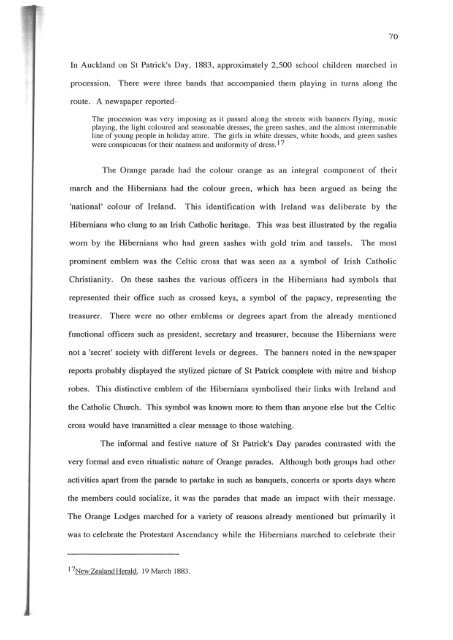TRANSPLANTED IRISH INSTITUTIONS - University of Canterbury
TRANSPLANTED IRISH INSTITUTIONS - University of Canterbury
TRANSPLANTED IRISH INSTITUTIONS - University of Canterbury
You also want an ePaper? Increase the reach of your titles
YUMPU automatically turns print PDFs into web optimized ePapers that Google loves.
70<br />
In Auckland on St Patrick's Day, 1883, approximately 2,500 school children marched in<br />
procession. There were three bands that accompanied them playing in turns along the<br />
route. A newspaper reported-<br />
The procession was very imposing as it passed along the streets with banners Oying, musIc<br />
playing, the light coloured and seasonable dresses, the green sashes, and the almost interminable<br />
line <strong>of</strong> young people in holiday attire. The girls in white dresses, white hoods, and green sashes<br />
were conspicuous for their neatness and uniformity <strong>of</strong> dress. 17<br />
The Orange parade had the colour orange as an integral component <strong>of</strong> their<br />
march and the Hibernians had the colour green, which has been argued as being the<br />
'national' colour <strong>of</strong> Ireland.<br />
This identification with Ireland was deliberate by the<br />
Hibernians who clung to an Irish Catholic heritage. This was best illustrated by the regalia<br />
worn by the Hibernians who had green sashes with gold trim and tassels.<br />
The most<br />
prominent emblem was the Celtic cross that was seen as a symbol <strong>of</strong> Irish Catholic<br />
Christianity. On these sashes the various <strong>of</strong>ficers in the Hibernians had symbols that<br />
represented their <strong>of</strong>fice such as crossed keys, a symbol <strong>of</strong> the papacy, representing the<br />
treasurer. There were no other emblems or degrees apart from the already mentioned<br />
functional <strong>of</strong>ficers such as president, secretary and treasurer, because the Hibernians were<br />
not a 'secret' society with different levels or degrees. The banners noted in the newspaper<br />
reports probably displayed the stylized picture <strong>of</strong> St Patrick complete with mitre and bishop<br />
robes. This distinctive emblem <strong>of</strong> the Hibernians symbolised their links with Ireland and<br />
the Catholic Church. This symbol was known more to them than anyone else but the Celtic<br />
cross would have transmitted a clear message to those watching.<br />
The infonnal and festive nature <strong>of</strong> St Patrick's Day parades contrasted with the<br />
very fonnal and even ritualistic nature <strong>of</strong> Orange parades. Although both groups had other<br />
activities apart from the parade to partake in such as banquets, concerts or sports days where<br />
the members could socialize, it was the parades that made an impact with their message.<br />
The Orange Lodges marched for a variety <strong>of</strong> reasons already mentioned but primarily it<br />
was to celebrate the Protestant Ascendancy while the Hibernians marched to celebrate their<br />
17NewZealandHerald, 19 March 1883.
















